Macro‑Friendly Meal Planning Hacks That Save Time and Calories

Balancing nutrition with a busy lifestyle can feel tricky, but it doesn’t have to be. I recently discovered Flexible Dieting Lifestyle’s macro‑friendly banana bread recipe, which packs protein, fibre, and moderate carbs into one satisfying snack. That simple find inspired me to explore how macro‑aware meal planning can simplify healthy eating and help busy Brits save both time and extra calories.
In this guide, you’ll find macro-friendly strategies, from batch cooking to smart swaps and snack hacks, that streamline your grocery list, reduce food waste, and keep your meals balanced without the hassle.
What Is Macro-Friendly Meal Planning?
Macro‑friendly meal planning means structuring meals with balanced ratios of protein, carbohydrates, and fats, the “macros.” This helps maintain stable energy levels, manage appetite, and support goals like fitness, weight control, or general health.
Rather than fixate on calories alone, focusing on the quality and balance of macros allows for satisfying meals (like banana bread or grain bowls) that serve appetite and nutrition equally.
1. Batch Cooking for the Week Ahead
One of the most time-saving habits is batch cooking. Choose two or three protein sources, grilled chicken, baked tofu, poached eggs, and cook them all at once. Combined with cooked grains and roasted vegetables, you can assemble meals in just a few minutes over the week.
Quick examples:
- Grain bowls with quinoa, chickpeas, and roasted veg
- Wraps with lean turkey, avocado, spinach, and hummus
- Macro-friendly banana bread as a breakfast slice or snack, paired with Greek yogurt or nut butter
Having macro-balanced staples ready frees up brain space and eliminates decision fatigue when hunger strikes.
2. Balanced Portioning with Containers
Divide meals into portioned containers: one compartment protein, one for carbs, and one for veg/fat. This visual separation makes maintaining macro balance easier and encourages controlled portions without counting every gram.
People using macros for weight or fitness often report fewer impulse meals and snacks when their meals are pre-portioned and macro-structured.
3. Smart Swaps & Ingredient Substitutions
Making macro-friendly swaps doesn’t mean sacrificing flavour. Options like Greek yogurt for sour cream, mashed banana for some sugar, or chickpeas instead of pasta can tweak macros without compromising taste.
If your banana bread has a vegan or whole-wheat twist, you can lower sugar content and raise nutrient density, perfect for satisfying sweet cravings without derailing macros.
4. Routine Snacking That Supports Energy
Routine snacking can be a drain if you’re relying on biscuits or crisps. Structured, macro-conscious snacking, like mixed nuts, protein balls, veggie sticks with hummus, or slices of macro banana bread, can stabilize blood sugar and maintain productivity through the afternoon.
Tip: Pair snacks with water or unsweetened hot drinks to promote hydration and satiety.
5. Nutrient Timing for Stability
Eating at regular intervals helps avoid energy crashes. Here’s a typical macro-friendly schedule:
- Breakfast (within 1 hour of waking): fast oats or smoothie with protein
- Lunch: macro-balanced bowl or wrap
- Snack (mid-afternoon): Greek yogurt, nuts, or banana‑based baked treat
- Dinner: lean protein with roasted veg and moderate grains or sweet potato
- After-dinner: a small macro snack (fruit, yogurt, or light grain bowl)
This structure prevents unpredictability and supports consistent energy levels.
Nutrition Framework: The NHS Eatwell Guide

Health authorities recommend balanced plate portions for sustainable nutrition. The NHS Eatwell Guide advises:
- ½ plate vegetables and fruit
- ¼ plate carbohydrates (wholegrain where possible)
- ¼ plate protein (beans, fish, lean meat)
- Small portion of healthy fats (olive oil, nuts)
These guidelines align perfectly with macro planning practices, reinforcing portion control and a balanced diet without needing complex calculations.
6. Using Templates and Pre-Planned Recipes
Start with templates based on standard macro targets:
- Example macro ratio: 30% protein, 40% carbs, 30% fats
Use fixed “template flows” such as:
- Grain + protein + veg
- Wrap + protein + leafy greens
- Smoothie bowl + fruit + protein powder + seeds
When you plug recipes from sites like Flexible Dieting Lifestyle into those frameworks, you save prep and can assess nutritional value at a glance.
7. Minimise Waste, Maximise Variety
Macro cooking isn’t just efficient, it’s flexible. Use vegetables and grains interchangeably (e.g. frozen veg can be swapped in easily). Rotating proteins (fish, lentils, chicken) keeps nutrients diverse and menus less repetitive.
If banana bread is getting stale before being eaten, freeze slices individually. This preserves freshness and offers a pre-portioned treat for later snacks or breakfast.
8. Work-Lifestyle Tips for Remote or Busy Days
For remote workers or professionals on the go:
- Keep meals and snacks in portioned boxes in the fridge
- Schedule 30-minute “mealtimes” devoid of screens
- Pack macro-friendly items into a bag if switching locations (e.g. between home and co-working spaces)
Having meals preorganized reduces impulsive eating and keeps remote days structured.
9. Minimal Cooking Skills, Maximum Impact
You don’t need chef-level skills. Many macro meals rely on simple steps: bake, boil, roast, assemble. Batch quinoa or rice, roast chickpeas, combine with protein and greens, dress with olive oil and lemon.
Macro-friendly banana bread recipes often require only mixing and baking, ideal beginners’ entry point into macro cooking. Grab a slice with breakfast or piece it into weekly snack routines.
10. Supporting Mindful Eating Habits
Macro planning isn’t just about numbers, it’s about mindfulness. Eating with intention keeps you connected to satiety signals and can reduce overeating. Taking time to portion meals, enjoy balanced snacks, and eat slowly ensures food energies your work, not distract it.
Real-Life Productivity Results
Time-saving meal routines consistently show productivity gains. Employees with consistent macros report fewer energy dips and reduced stress around food choices at work.
One small British wellbeing survey found that individuals who meal-prep consistently saved about 90 minutes daily while consuming fewer ultra-processed snacks and maintained more consistent energy.
FAQs for UK Macro Meal Planners
Q: Are macro plans suitable even for non-athletes?
A: Yes. You don’t need to hit gym-level protein targets, just a balanced portion size and simple ingredients adds value.
Q: Is meal planning more expensive?
A: No. Buying staples like oats, beans, grain, eggs in bulk and cooking at home often decreases costs compared to takeout or packaged “diet” foods.
Q: What if I’m allergic or vegan?
A: Alternate protein sources (tofu, lentils, seitan), plant-based milk, and nut butter still provide macros. Banana bread swaps ingredients easily.
Macro-friendly meal planning isn’t about diet rules, it’s about structure, simplicity, and nutritious satisfaction. With batch prep, portion containers, snack routines, and smart timing, you can significantly reduce both time spent and unnecessary calories over the week.
Platforms like Flexible Dieting Lifestyle provide easy, appealing macro recipes like their banana bread that help bridge convenience with dietary balance. These kinds of tools show how macro awareness can fit seamlessly into everyday routines, especially for busy UK readers looking to reclaim energy, meal control, and time.



